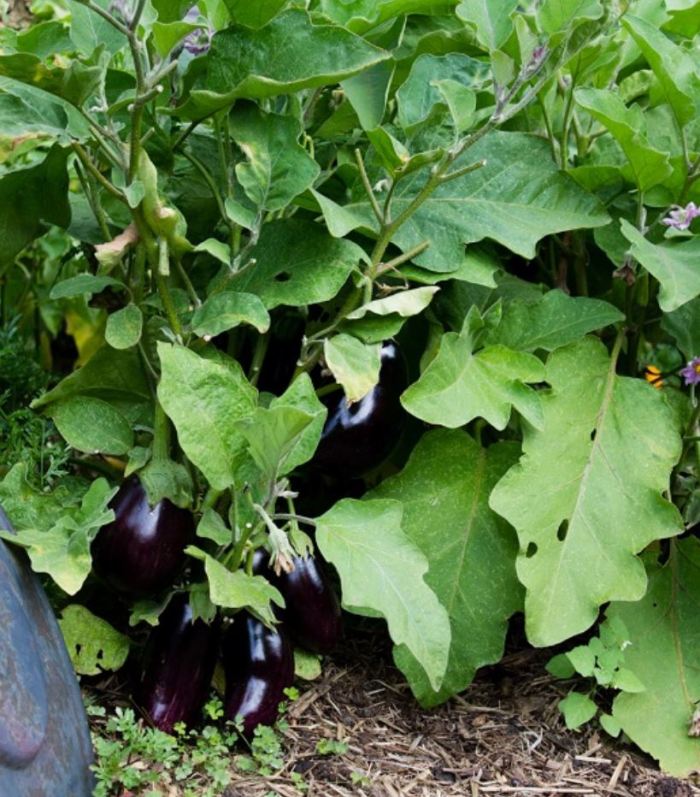Secrets for growing eggplants in pots and in your garden
Eggplant is one of the most important ingredients of Mediterranean cuisine. We have all loved it in famous summer recipes. Originally from Asia, eggplant is a high-nutrition vegetable with lots of antioxidants. We can plant it both in the garden and in the flower pot on the balcony without much difficulty. Eggplant is also eaten roasted and fried. We avoid eating it raw because of the bitter taste and also of the solanine, a toxic substance it contains, especially when harvested prematurely. Among the traditional and local aubergine varieties, we distinguish the Lagadas aubergine variety with the long purple fruit, the purple fillet aubergine, the two-color tsunami eggplant with white and violet marigold and and the sweet taste.

Simple DIY vegetable garden design ideas for inspiration
What should we know about eggplant planting?
First of all, it is important to cultivate eggplant varieties of our own seed that we maintain, so that we know the particular characteristics of each variety and how it adapts to the conditions in our area. Eggplant seed is slow to germinate and needs at least 2 weeks to germinate under ideal conditions of 20 ° C and relative humidity. Eggplant is more warm-growing than tomato and pepper and much more sensitive to low temperatures. That is why we make sure to plant it from April onwards, when the temperature has risen sharply. Eggplant thrives on fluffy fertile soils that have good drainage. Before planting the eggplant, after we plant our garden, we incorporate enough organic matter into the compost pits in the form of compost and well digested manure, as well as complete biological fertilizer. We avoid planting eggplants to achieve better plant ventilation, limiting the development of fungal diseases, and improving eggplant production. Suitable planting distances are 50–60 cm between plants and 80–120 cm between planting lines.

What are the needs of aubergine for watering, fertilizing and other care?
Eggplant cultivation has significant water needs to be efficient and requires regular watering with the drip system. During the flowering of the eggplant, lack of water can cause the flowers to fall. Also, when fruiting the aubergine, continuous watering is needed, especially during the hot summer months, to avoid the formation of bitter-tasting fruits. To enjoy sweet eggplants, we add potassium and calcium fortified organic fertilizer every 3-4 weeks to help produce quality and tasty fruit. Lack of calcium in eggplant, as in pepper and tomato, can cause the dry top effect, where the fruits tan at the edges. Outdoor aubergine cultivation, either in the garden or in the flowerpot on the balcony, does not require pruning as opposed to greenhouse eggplant varieties. To support the plants, we can use a simple one-meter-long reed on which the central shoot of eggplant will attach.
Radishes, secrets for planting and growing in your garden or in a flower pot in your balcony
How do we deal with quail, insects and other aubergine diseases?
The squirrel, this annoying spider, is the most important enemy of eggplant cultivation. As temperatures begin to rise in the summer, the squirrel stays on the leaves and fruits of the eggplant. Eggplant is also affected by insects of mullet, thrips and chickpeas, as well as fungal diseases of mildew. We use sulfur and thiohalcine to treat the sesame and fungal diseases of aubergine ecologically, while protecting ourselves against insects, we make our own ecological preparations with natural materials in our home such as garlic, onion, green soap. Alternatively, we can supply potassium soaps and natural pyrethrin from agricultural shops with which we spray eggplant every 2 weeks.

And one last secret about growing eggplant
The eggplant is harvested about 2.5 months after transplanting, depending on the variety and weather conditions. We collect the aubergine fruits at a stage that is not fully ripened, that is, when they have a tight flesh and shiny purple color. At harvest, cut the eggplant fruit with a portion of the pod for better maintenance. Eggplant is not kept out of the refrigerator, and in the refrigerator it deteriorates rapidly after a few days due to low temperatures.
9 Secrets to planting and growing lettuce in your garden













Images via: Pinterest







3 comments
[…] of white eggplant before, but what exactly is the difference between white eggplant and purple eggplant? Aside from the color, white eggplant has a sweeter and less bitter taste than purple eggplant. It […]
[…] you have the option of growing small-caliber, cherry-type, or early tomatoes. Forget about eggplants, peppers and melons, which require full […]
[…] Here are some vegetables that don’t sit next to each other, but also find out which vegetables make a good house next to tomatoes so that you can grow them too. It is said that tomato is a fruit, but everyone uses it and cooks it like a vegetable. No matter what you choose to call it, tomato is part of the Solanaceae botanical family, along with peppers and eggplant. […]
Comments are closed.